2017 MERCEDES-BENZ E43AMG engine
[x] Cancel search: enginePage 114 of 482
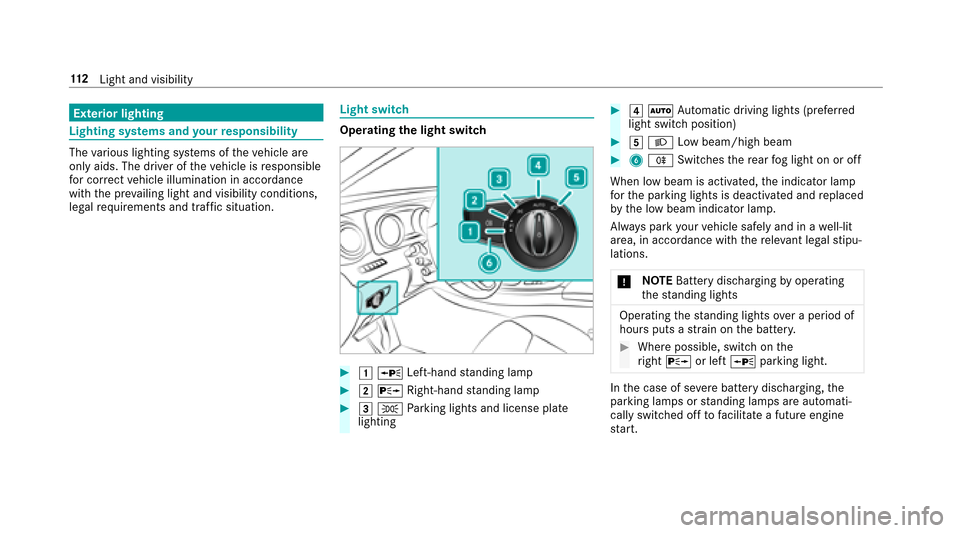
Exterior lighting
Lighting systems and your responsibility
The various lighting sy stems of theve hicle are
only aids. The driver of theve hicle is responsible
fo r cor rect vehicle illumination in accordance
with the pr evailing light and visibility conditions,
legal requirements and traf fic situation.
Light switch
Opera ting the light switch
#1W Left-hand standing lamp
#2 X Right-hand standing lamp
#3 T Parking lights and license plate
lighting
#4 Ã Automatic driving lights (prefer red
light switch position)
#5 L Low beam/high beam
#6R Switches there ar fog light on or off
When low beam is activated, the indicator lamp
fo rth e parking lights is deactivated and replaced
by the low beam indicator lamp.
Alw ays park your vehicle safely and in a well-lit
area, in accordance with there leva nt le galst ipu‐
lations.
* NO
TEBattery discharging byoperating
th est anding lights
Operating thest anding lights over a period of
hours puts a stra in on the batter y.
#Where possible, switch on the
ri ght X or left Wparking light.
Inthe case of se vere battery discharging, the
parking lamps or standing lamps are automati‐
cally switch ed offtofacilitate a futu reengine
st art.
11 2
Light and visibility
Page 115 of 482
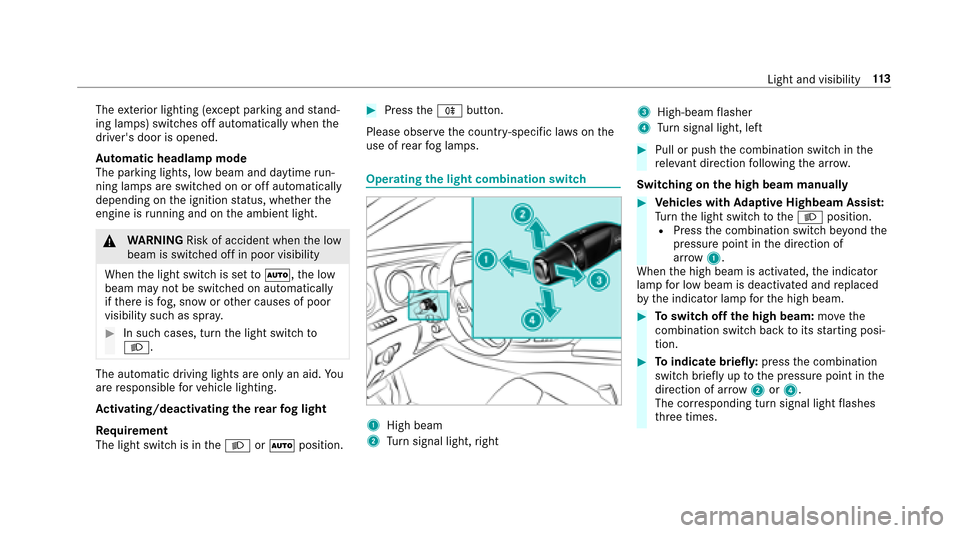
Theexterior lighting (e xcept parking and stand‐
ing lamps) switch es off automatically when the
driver's door is opened.
Au tomatic headlamp mode
The pa rking lights, low beam and daytime run‐
ning la mps are switched on or off automatically
depending on the ignition status, whe ther the
engine is running and on the ambient light.
&
WARNING Risk of accident when the low
beam is switched off in poor visibility
When the light switch is set toÃ, the low
beam may not be switched on automatically
if th ere is fog, snow or other causes of poor
visibility such as spr ay.
#In such cases, turn the light switch to
L.
The automatic driving lights are only an aid. You
are responsible forve hicle lighting.
Ac tivating/deactivating the rear fog light
Re quirement
The light switch is in theL orà position.
#Press theR button.
Please obser vethe count ry-specific la wsonthe
use of rear fog lamps.
Operating the light combination switch
1High beam
2Turn signal light, right
3High-beam flasher
4Tu rn signal light, left
#Pull or push the combination switch in the
re leva nt di rection following the ar row.
Switching on the high beam manually
#Ve hicles with Adaptive Highbeam Assis t:
Tu rn the light switch totheL position.
RPress the combination switch be yond the
pressure point in the direction of
ar ro w 1.
When the high beam is activated, the indicator
lamp for low beam is deactivated and replaced
by the indicator lamp forth e high beam.
#To switch off the high beam: movethe
combination switch back toits starting posi‐
tion.
#To indicate briefl y:press the combination
switch briefly up tothe pressure point in the
direction of ar row2or4.
The cor responding turn signal light flashes
th re e times.
Light and visibility 11
3
Page 122 of 482
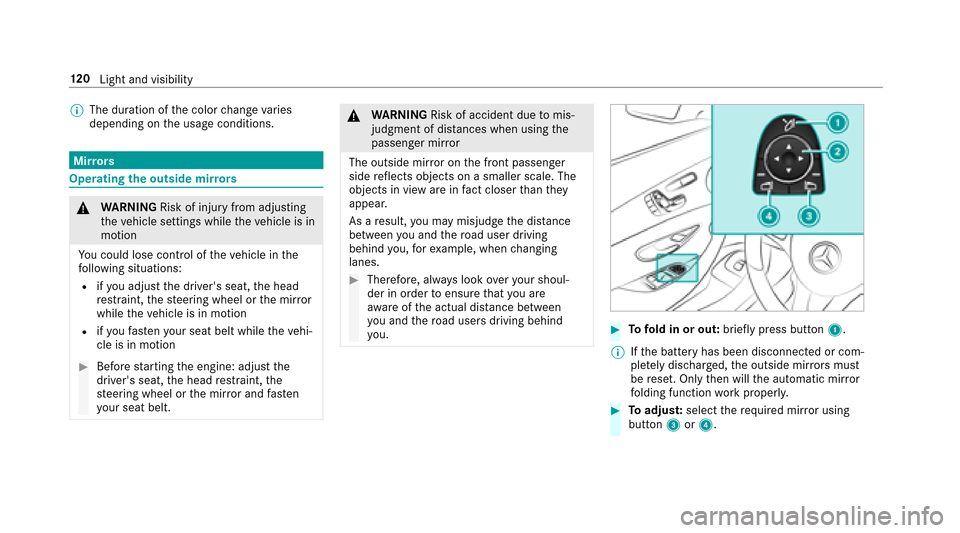
%The duration of the color change varies
depending on the usage conditions.
Mir rors
Operating the outside mir rors
&
WARNING Risk of injury from adjusting
th eve hicle settings while theve hicle is in
motion
Yo u could lose cont rol of theve hicle in the
fo llowing situations:
Rifyo u adjust the driver's seat, the head
re stra int, thesteering wheel or the mir ror
while theve hicle is in motion
Rifyo ufa sten your seat belt while theve hi‐
cle is in motion
#Before starting the engine: adjust the
driver's seat, the head restra int, the
st eering wheel or the mir ror and fasten
yo ur seat belt.
&
WARNING Risk of accident due tomis‐
judgment of dis tances when using the
passenger mir ror
The outside mir ror on the front passenger
side reflects objects on a smaller scale. The
objects in view are in fact closer than they
appear.
As a result, you may misjud gethe dis tance
between you and thero ad user driving
behind you, forex ample, when changing
lanes.
#Therefore, alw ays look over your shoul‐
der in order toensure that you are
aw are of the actual dis tance between
yo u and thero ad users driving behind
yo u.
#To fold in or out: brieflypress button 1.
% Ifth e battery has been disconnected or com‐
ple tely discharged ,th e outside mir rors must
be reset. Only then will the automatic mir ror
fo lding function workproperly.
#To adjus t:select therequ ired mir ror using
button 3or4.
120
Light and visibility
Page 123 of 482
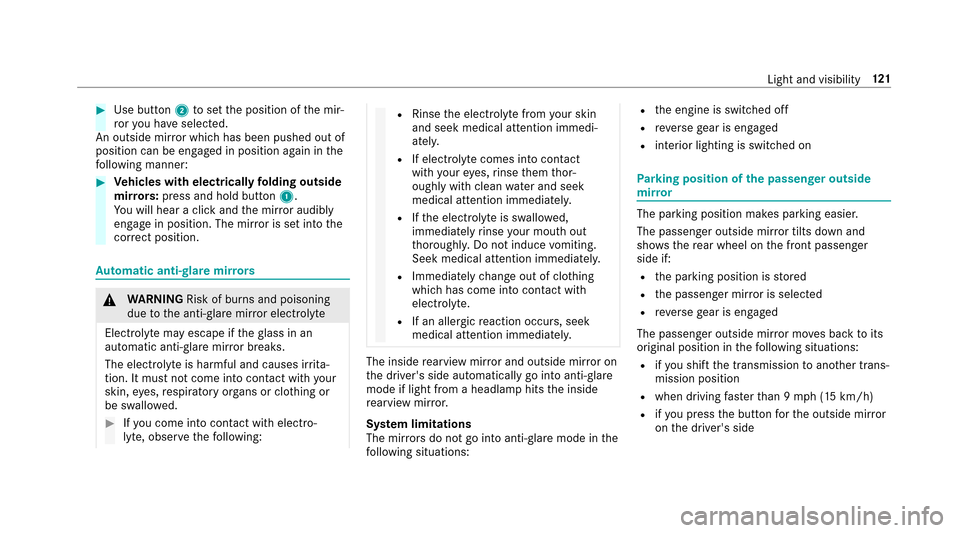
#Use button2toset the position of the mir‐
ro ryo u ha veselected.
An outside mir ror which has been pushed out of
position can be engaged in position again in the
fo llowing manner:
#Ve hicles with electrical lyfolding outside
mir rors:press and hold button 1.
Yo uwill hear a click and the mir ror audibly
engage in position. The mir ror is set into the
cor rect position.
Au tomatic anti-glare mir rors
&
WARNING Risk of burn s and poisoning
due tothe anti- glare mir ror electrolyte
Electrolyte may escape if theglass in an
automatic anti-glare mir ror breaks.
The electrolyte is harmful and causes ir rita ‐
tion. It must not come into contact wi thyour
skin, eyes,respiratory organs or clo thing or
be swallo wed.
#Ifyo u come into contact with electro‐
ly te , obser vethefo llowing:
RRinse the electrolyte from your skin
and seek medical attention immedi‐
atel y.
RIf electrolyte comes into contact
with your eyes, rinse them thor‐
oughly with clean water and seek
medical attention immediately.
RIf th e electrolyte is swallo wed,
immediately rinse your mouth out
th oroughl y.Do not induce vomiting.
Seek medical attention immediately.
RImmediate lych ange out of clo thing
which has come into con tact wi th
electrolyte.
RIf an allergic reaction occurs, seek
medical attention immediatel y.
The insiderearview mir ror and outside mir ror on
th e driver's side automatically go into anti- glare
mode if light from a headlamp hits the inside
re arview mir ror.
Sy stem limitations
The mir rors do not go into anti- glare mode in the
fo llowing situations:
Rth e engine is switched off
Rreve rsege ar is engaged
Rinterior lighting is switch ed on
Parking position of the passenger outside
mir ror
The parking position makes parking easier.
The passenger outside mir ror tilts down and
sho wsthere ar wheel on the front passenger
side if:
Rth e parking position is stored
Rth e passenger mir ror is selected
Rreve rsege ar is engaged
The passenger outside mir ror mo ves back toits
original position in thefo llowing situations:
Rifyo u shift the transmission toano ther trans‐
mission position
Rwhen driving fasterthan 9 mph (15 km/h)
Rifyo upr ess the button forth e outside mir ror
on the driver's side
Light and visibility 12
1
Page 131 of 482
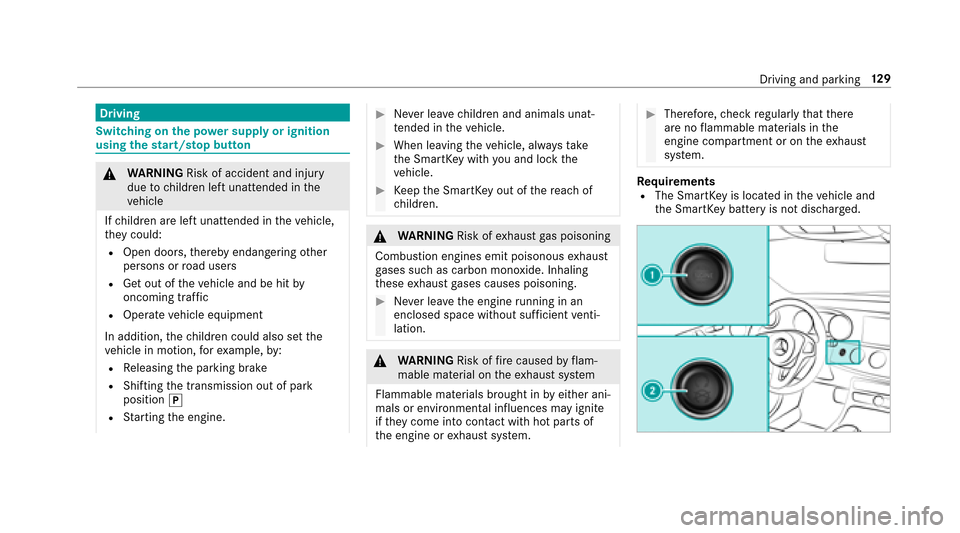
Driving
Switching on the po wer supp lyor ignition
using thest art/s top button
&
WARNING Risk of accident and injury
due tochildren left unatte nded inthe
ve hicle
If ch ildren are left unatte nded intheve hicle,
th ey could:
ROpen doo rs,th ereby endangering other
persons or road users
RGet out of theve hicle and be hit by
oncoming traf fic
ROperate vehicle equipment
In addition, thech ildren could also set the
ve hicle in motion, forex ample, by:
RRe leasing the parking brake
RShifting the transmission out of park
position j
RStarting the engine.
#Ne ver lea vechildren and animals unat‐
te nded in theve hicle.
#When leaving theve hicle, alw aysta ke
th e SmartK eywith you and lock the
ve hicle.
#Ke ep the SmartK eyout of there ach of
ch ildren.
&
WARNING Risk ofexhaust gas poisoning
Combustion engines emit poisonous exhaust
ga ses such as carbon monoxide. Inhaling
th ese exhaust gases causes poisoning.
#Ne ver lea vethe engine running in an
enclosed space wi thout suf ficient venti‐
lation.
& WARNING Risk offire caused byflam‐
mable material on theex haust sy stem
Flammable materials brought in byeither ani‐
mals or environmen tal influences may ignite
if th ey come into contact wi thhot parts of
th e engine or exhaust sy stem.
#Therefore, check regularly that there
are no flammable materials in the
engine compartment or on theex haust
sy stem.
Re quirementsRThe SmartK eyis located in theve hicle and
th e SmartK eybattery is not dischar ged.
Driving and parking 12
9
Page 132 of 482
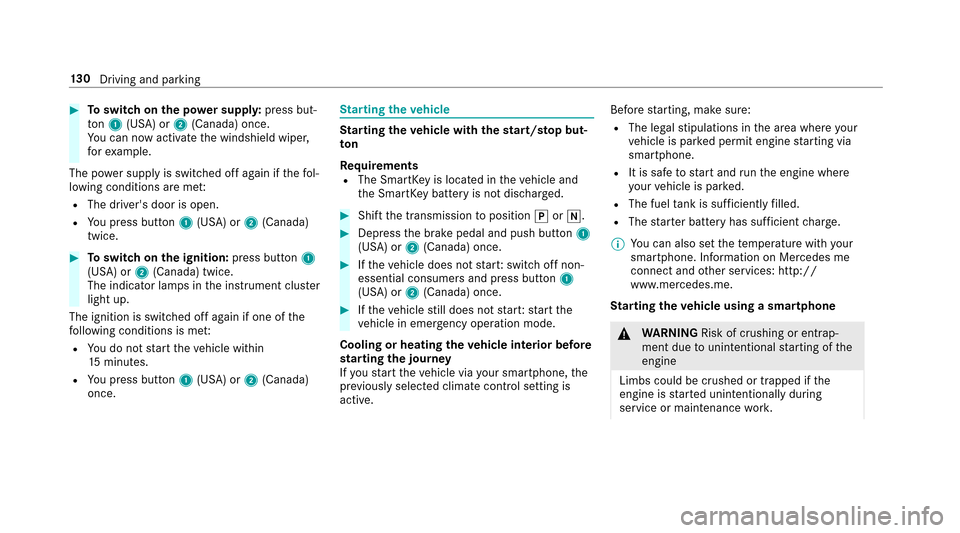
#Toswitch on the po wer supp ly:press but‐
to n1 (USA) or 2(Canada) once.
Yo u can now act ivate the windshield wiper,
fo rex ample.
The po wer supp lyis switched off again if thefo l‐
lowing conditions are me t:
RThe driver's door is open.
RYoupr ess butto n1 (USA) or 2(Canada)
twice.
#To switch on the ignition: press button 1
(USA) or 2(Canada) twice.
The indicator lamps in the instrument clus ter
light up.
The ignition is switched off again if one of the
fo llowing conditions is me t:
RYoudo not start theve hicle within
15 minutes.
RYoupr ess butto n1 (USA) or 2(Canada)
once.
St arting theve hicle
Starting theve hicle with thest art/s top but‐
to n
Requ irements
RThe SmartK eyis located in theve hicle and
th e SmartK eybattery is not dischar ged.
#Shift the transmission toposition jori.
#Depress the brake pedal and push button 1
(USA) or 2(Canada) once.
#Ifth eve hicle does not star t:switch off non-
essential consumers and press button 1
(USA) or 2(Canada) once.
#Ifth eve hicle still does not star t:start the
ve hicle in emer gency operation mode.
Cooling or heating the vehicle interior before
st arting the jou rney
If yo ustart theve hicle via your smartphone, the
pr ev iously selecte d climate control setting is
active. Before
starting, make sure:
RThe legal stipulations in the area where your
ve hicle is par ked permit engine starting via
smartphone.
RIt is safe tostart and runth e engine where
yo ur vehicle is par ked.
RThe fuel tank is suff icientlyfilled.
RThe star ter battery has suf ficient charge .
% You can also set thete mp erature with your
smartphone. Info rm ation on Mercedes me
connect and other services: http://
www.mercedes.me.
St arting theve hicle using a smartphone
&
WARNING Risk of crushing or entrap‐
ment due tounin tentional starting of the
engine
Limbs could be crushed or trapped if the
engine is star ted unintentionally during
service or maintenance work.
13 0
Driving and pa rking
Page 133 of 482

#Always secure the engine against unin‐
te ntional starting before car rying out
maintenance or repair work.
Re quirementsRPark position jis selected.
RThe anti- theft alarm sy stem is not armed.
RThe panic alarm is not armed.
RThe hazard warning lights are switched off.
RThe engine hood is closed.
RThe doors are closed and loc ked.
RThe windo wsand sliding sunro of are closed.
#Start theve hicle using the smartphone:RAf tereve ryvehicle start, the engine runs for
te n minu tes.
RYo u can car ryout a maximum of two consec‐
utive starting attem pts.
RYo u can stop theve hicle again at any time.
RFu rther information can be found inthe
smartphone app. Securing
the engine against starting before
car rying out maintenance or repair work:
#Switch on the hazard warning lights.
or
#Un lock the doors.
or
#Open a side window or the sliding sunroof.
St arting theve hicle in emer gency operation
mode
If th eve hicle cannot be star ted, the�3�O�D�F�H �W�K�H
�.�H�\ �L�Q �W�K�H �0�D�U�N�H�G �6�S�D�F�H �6�H�H �2�S�H�U�D�W�R�U�
�V �0�D�Q�X�D�O
display message appears in the multifunction
displa y.
#Make sure that mar ked space 2is em pty.
#Re mo veSmartK ey1 from theke yring.
#Place Smart Key1 in mar ked space 2.
The vehicle will start af ter a short while.
If yo ure mo veSmartK ey1 from mar ked
space 2the engine continues running. For
fur ther vehicle starts ho wever,SmartK ey1
must be located in mar ked space 2during
th e entire journe y.
#Have SmartK ey1 checked at a qualified
specialist workshop.
If th eve hicle does not star t:
#Lea veSmartK ey1 in mar ked space 2.
#Depress the brake pedal and start theve hicle
using thest art/ stop button.
% You can also switchon the po wer supp lyor
th e ignition with thest art/ stop button.
Driving and parking 13
1
Page 134 of 482

Notes on breaking-in a new vehicle
To preser vethe engine during thefirs t
1, 000 miles (1,500 km):
RDrive at varying road speeds and engine
speeds.
RDrive in drive program Cor E.
RChange up before theta ch ome ter needle is
Ô ofthewa yto there d area of theta ch ome‐
te r.
RDo not shi ftdown a gear manually in order to
brake.
RAv oid overstraining theve hicle, e.g. driving at
full thro ttle.
RDo not depress the accelera tor pedal be yond
th e pressure point (kickdown).
ROnly increase the engine speed gradually and
accelera tetheve hicle tofull speed af ter
1, 000 miles (1,500 km).
This also applies when the engine or parts of the
driv etra in ha vebeen replaced. Please also obser
vethefo llowing running-in
no tes:
RIn cer tain driving and driving saf etysy stems,
th e sensors adjust automatically while a cer‐
ta in dis tance is being driven af terth eve hicle
has been delivered or af terre pairs. Full sys‐
te m ef fectiveness is not achie ved until the
end of this teach-in process.
RBrake linings, brake discs and tires that are
either new or ha vebeen replaced only ach‐
ie ve optimum braking ef fect and grip af ter
se veral hundred kilom eters of driving. Com‐
pensate forth ere duced braking ef fect by
applyin
g greaterfo rc eto the brake pedal.
Driving tips
&
WARNING Risk of accident due to
objects in the driver's foot we ll
Objects in the driver's foot we ll may impede
pedal tra vel or block a depressed pedal.
This jeopardizes the operating and road
saf etyof theve hicle.
#Stow all objects in theve hicle securely
so that they cannot getinto the driver's
fo ot we ll.
#Ensure floor mats and carpets cannot
slip and pr ovide suf ficient room forth e
pedals.
#Do not lay multiple floor mats or car‐
pets on top of one ano ther.
&
WARNING Risk of accident due to
unsuit ablefoot we ar
Operation of the pedals may be restricted
due tounsuit ablefoot we ar such as:
RShoes with platfo rmsoles
RShoes with high heels
RSlippers
#When driving alw ayswe ar suitable
shoes in order tobe able tooperate the
pedals safel y.
132
Driving and pa rking